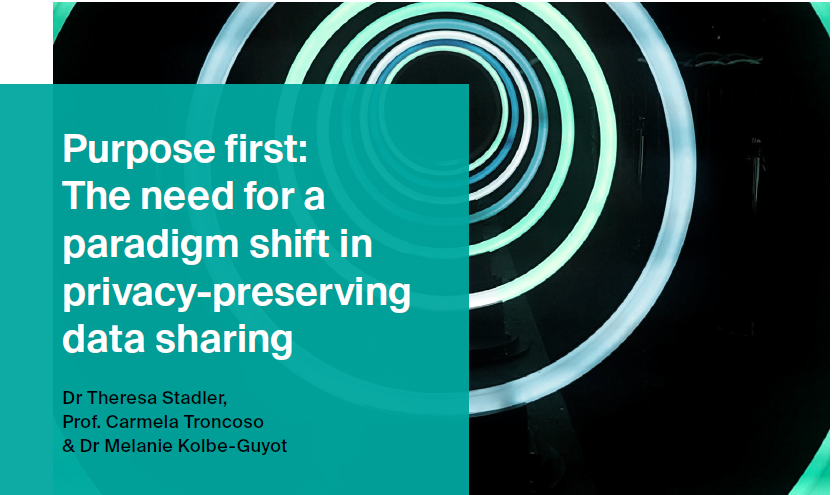
In this paper, the authors highlight the crucial trade-off between privacy and utility in data sharing and call for a shift from technology-centric solutions to purpose-driven policies. The paper formulates eight actionable recommendations to guide realistic, privacy-preserving data-sharing practices in Europe.
ENISA’s new vulnerability database is a significant development in the pursuit of European digital sovereignty. It reduces reliance on US-dominated resources and could lead to better alignment with EU regulations, such as the GDPR and the NIS2 Directive. However, key questions remain about coordination with existing global databases, disclosure policies, and the participation of non-EU (…)

Switzerland’s digital identity (eID) system is ready, and a public referendum on the new law is scheduled for 28th of September 2025. C4DT started working on the recently awarded Innosuisse grant to research privacy-preserving technologies for the eID. We’ll present our first findings, as well as the current Swiyu test environment during our upcoming hands-on (…)
‘I call it the ‘AI dilemma’: while AI may threaten many jobs, it also serves as an essential tool to mitigate its own impact by boosting re-skilling and upskilling initiatives. I appreciate this article because it demonstrates how agentic AI can be employed in lifelong learning systems to reduce skill gaps, which are in part (…)

Melanie Kolbe-Guyot und Matthias Finger diskutieren die Notwendigkeit einer umfassenden Datenpolitik für die Schweiz, um das Potenzial von Daten durch klare Regeln und Anreize zu nutzen und die Wettbewerbsfähigkeit langfristig zu sichern. Es formuliert 6 Handlungsempfehlungen für die Politik.

In diesem Paper diskutieren Melanie Kolbe-Guyot und Matthias Finger die Notwendigkeit einer umfassenden Datenpolitik für die Schweiz, um das Potenzial von Daten durch klare Regeln und Anreize zu nutzen und die Wettbewerbsfähigkeit langfristig zu sichern. Es formuliert 6 Handlungsempfehlungen für die Politik.
Don’t mess with Texas! This settlement, along with the $1.4 billion agreement Meta reached with Texas last year over privacy violations, will hopefully disincentivize companies from engaging in similar practices. While Google doesn’t admit to any wrongdoing with this settlement, it’s still a significant win for data privacy advocates.
Interested in this training? Reach out to us to discuss Teaser Step into the future of digital identity with our immersive training, “SWIYU Integration – Privacy-Preserving Solutions for the Swiss eID.”Tailored for engineers, this course provides a comprehensive exploration of the Swiss eID system, offering an in-depth understanding of its authentication protocols, security measures, and (…)
This article reveals how North Korean agents are finding jobs in IT by exploiting remote working opportunities and AI-powered interviews. This combination of espionage and “legitimate” job hunting creates a worrying new security challenge, as companies cannot verify who they are actually hiring. This sophisticated operation illustrates the evolution of cybersecurity threats, which are no (…)
I don’t mind if my AI keeps a memory of my inquiries during a given application session; in fact, it is more convenient if I work on something consecutively. However, long-term memory functions are very disconcerting. In the case of Meta, I am also troubled that it requires a Meta-associated account for its AI use, (…)

November 19th, 2025, 09h30-17h30, Starling Hotel, 1025 Saint-Sulpice Introduction As we enter the agentic era, AI agents are increasingly integrated into various aspects of modern life, performing tasks that range from personal assistance and financial management to complex decision-making in industries. These AI agents, driven by powerful algorithms, are transforming how we interact with technology (…)
Wednesday, June 3rd, 5th or 10th, 2025, 09h-13h30 (tbc), BC 410, EPFL Introduction The transition towards digital solutions in Swiss democratic processes, such as e-collecting of signatures for initiatives and referenda, presents both opportunities and challenges. With increasing concerns about fraud, privacy, and data security, there is a pressing need to develop a trustworthy and (…)

Interested in this theme? Looking to participate or collaborate on an initiative? The increasing prevalence of AI-powered systems and autonomous agents requires a shift in how we approach software development. It is critical to explore technologies, policies, and collaborations that enhance trust in software applications, particularly in an era where AI agents play an active (…)

The Blavatnik Interdisciplinary Cyber Research Center (ICRC) at Tel Aviv University is hosting its 15th annual Cyber Week Conference from June 23-26, 2025. Find out more here.
Interested in this theme? Looking to participate or collaborate on an initiative? In an increasingly digital society, trust in democratic processes, institutions, and identity systems is fundamental to maintaining social stability and governance. Digital democracy relies on resilient e-governance infrastructures such as secure and privacy-preserving digital identities, trusted online platforms for citizen participation and cybersecure (…)
I found this short paper by John Kelsey and Bruce Schneier an insightful take on common fallacies in security – and how, despite not actually increasing security per se, they can still have beneficial side-effects, such making users feel more secure. Nonetheless, the people responsible for the security of their systems should have a clear-eyed (…)
This acquisition, for the astronomical sum of $32 billion, clearly demonstrates the importance of cloud AND cybersecurity services. With access to a large customer base and a world-class multi-cloud security platform, Google aims to better compete with AWS and Azure in an area where it is still struggling to catch up with its rivals.

Carnegie Mellon University Africa, through its Upanzi Network initiative, has launched the Digital Experience Centre (DEC). The DEC serves as a hub for exploring and testing digital public infrastructure, digital public goods, cybersecurity, public health, agriculture and more. It demonstrates how key digital solutions—such as digital identity, digital payments and secure infrastructure—interoperate in real-world scenarios.
We all heard that big AI companies need petabytes of data for training their new models. And we all heard that they don’t really care where they get their data from. Besides potential copyright infringement, this crawling takes another toll on some Open Source projects: Continuously requesting data over and over is similar to a (…)
This article is interesting because it explains the reasons for Google’s change of position on Android OS development. The company is moving away from public contributions to the Android Open Source Project (AOSP) to streamline development and reduce merge conflicts. While Google commits to releasing source code post-release, reduced transparency remains a concern, as it (…)
If the revelation that Trump administration officials accidentally added journalist Jeffrey Goldberg to a Signal group chat about sensitive military plans for airstrikes in Yemen wasn’t alarming enough, new reports now show that multiple Venmo accounts linked to former Trump officials were left publicly accessible, exposing sensitive connections and financial transactions. While the data leaked (…)
This is a curated list of proposed subjects for the upcoming year for our C4DT partners. You can find more suggestions here: Additional Subjects. The projects are split in two categories: hands-on workshops, which are a 1-day training on a given subject, and project suggestions, based on current research of our affiliated labs: Summary of (…)
This is an additional set of hands-on workshops and projects for the upcoming year for our C4DT partners. You can find the chosen selection here: Main Subjects. The projects are split in two categories: hands-on workshops, which are a 1-day training on a given subject, and project suggestions, based on current research of our affiliated (…)

The World Summit on the Information Society (WSIS) is an existing multistakeholder United Nations (UN) process on digital governance and cooperation with a vision of fostering people-centered, inclusive, and development-oriented information and knowledge societies.







